| Pages:
1
2
3
4 |
Metacelsus
International Hazard
    
Posts: 2531
Registered: 26-12-2012
Location: Boston, MA
Member Is Offline
Mood: Double, double, toil and trouble
|
|
Yeah, sodium amide probably wouldn't work; you'd need a non-nucleophilic base.
By the way, I'm almost done on my batch of triacetonamine. I should have the workup done by the end of the weekend.
[Edited on 20-11-2014 by Cheddite Cheese]
|
|
|
CuReUS
National Hazard
   
Posts: 928
Registered: 9-9-2014
Member Is Offline
Mood: No Mood
|
|
it is a non nucleophilic base,when it is used in the "absence" of ammonia or other polar liquids that are electron rich
http://www.masterorganicchemistry.com/2011/07/29/reagent-fri...
read the last heading on that page -"conversion of acyl halides to amides
and this
http://en.wikipedia.org/wiki/Sodium_amide#Uses
actually in all the reactions i saw in which soda amide was used to alkylate ,carboxylic acids or esters were used .
even if the base pulled out a hydrogen from the COOH ,it would go into resonance and not interfere in the reaction at all
and for esters,there is no hydrogen itself ,so there is no problem .
that made me wrongly assume that the same thing would happen for acid chloride
but i came up with another method
instead of malonyl chloride ,we can use 1,3 dichloropropane
which can be made from propan 1,3 diol
http://en.wikipedia.org/wiki/1,3-Propanediol
the wiki page says that it is used in antifreeze
it can be also made by hydration of acrolein,which in turn can be made by dehydration of glycerol or by just heating glycerol
http://en.wikipedia.org/wiki/Acrolein#Production
although i couldnt find an article for making 1,3 dichloropropane ,i saw this
http://www.orgsyn.org/demo.aspx?prep=cv6p0556
under "discussion"
"in one instance, 1,3-dibromopropane was treated with sodium thiosulfate to form a precursor of the dithiol ...."
so similarly could the diol be refluxed with HCl in the presence of anhydrous ZnCl2 or treated with thionyl choride to get the dichoro
then disopropylamine oxide is treated with sodamide or tertbutoxide ,aluminum isopropoxide ,sodium ethoxide or just plain old alcoholic KOH to
deprotonate it
this is treated with the 1,3 dichloro to get TEMPO
(instead of doing it in one pot,one could first react the di-iso oxide with the base to deprotonate it,then drip that slowly into a flask of 1,3
dichloro propane .since there will be very less unreacted amide in every drop and there is an excess of the dichloro,such substitution side reactions
could be avoided.most of the ammonia formed in the first reaction would bubble out and even if some came into the flask and caused some dichloro
molecules to be substituted,HCl would form that would neutralize the remaining ammonia)
instead of substitution ,some of the dichloro may get dehydrohalogenated.but cant alkenes also act as nucleophiles
http://www2.dupont.com/Sustainable_Solutions/en_US/assets/do...
and since only very little unreacted sodamide from the first beaker will cause this dehydrohalogenation,i dont think both the chlorine atoms will be
removed
so in the worst case scenario ,allyl chloride will form which can still carry out the reaction
i didnt know that propan 1,3 diol was OTC ,or i would have never used malonyl chloride
my first idea was to use this 
http://en.wikipedia.org/wiki/Bis%28chloromethyl%29_ketone
[Edited on 21-11-2014 by CuReUS]
|
|
|
Praxichys
International Hazard
    
Posts: 1063
Registered: 31-7-2013
Location: Detroit, Michigan, USA
Member Is Offline
Mood: Coprecipitated
|
|
Hey Cheddite, how did the workup go? Any luck? I'm on my way with the gassing...
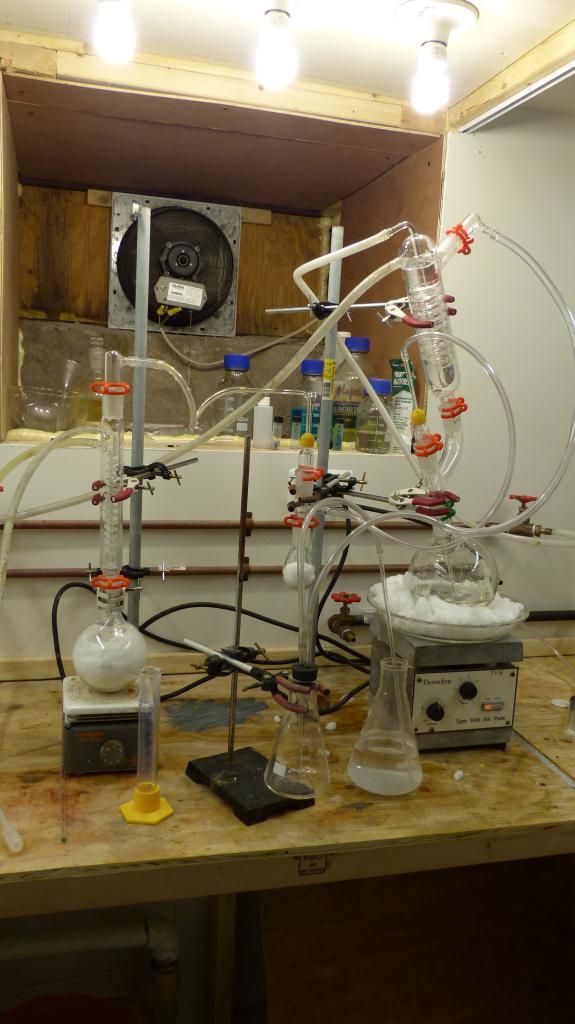
|
|
|
Metacelsus
International Hazard
    
Posts: 2531
Registered: 26-12-2012
Location: Boston, MA
Member Is Offline
Mood: Double, double, toil and trouble
|
|
I'm still doing it. I said it would be done by the end of the weekend, and I still think it will be.
|
|
|
CuReUS
National Hazard
   
Posts: 928
Registered: 9-9-2014
Member Is Offline
Mood: No Mood
|
|
what about this method
start from lysine -can be obtained at nutrient stores
http://www.amazon.com/L-Lysine-1000g-Powder-Pharmaceutical-Q...
then do strecker degradation with hypochlorite
http://en.wikipedia.org/wiki/Strecker_degradation
you will get 5-aminopentanal (i have read in the acetaldehyde synthesis thread in organic chemistry section that you might get primary nitriles but
that's ok as the nitriles will get hydrolysed to the acid that i am eventually going to make)
treat this with HNO2 (NaNO2 +HCl) ,you could get nitrite from butcher salts as chemosynthesis said
this will convert the terminal amine to alcohol
so you have 5-hydroxypentanal
now oxidise this with KMnO4(alkaline not acidic) to get pentan-1,4 dioc acid or glutaric acid
http://en.wikipedia.org/wiki/Glutaric_acid
esterify with ethanol to get diester
now is the hard part
treat this with grignard(methyl magnesium iodide) to convert it to tertiary alcohol
http://www.sciencemadness.org/talk/viewthread.php?tid=12475
i know that Mg is not OTC ,so you can use methyl lithium instead ,but methyl lithium is pyrophoric
now ,get completely anhydrous ethanol(you can get that by distilling the 95% alcohol with CaCl2 or MgCl2) and pass ammonia
through that(you would have to dry the ammonia gas first by passing it through a tube packed with NaOH pellets)
then react this ethanolic solution with the diol to get cyclic amine
as the absolute alcohol acts as a dehydrating agent
http://www.inkling.com/read/suvarna-bancrofts-theory-practic...
then you can oxidise the cyclic amine to get TEMPO
i have a little doubt in the last step of the dehydration
as sulphuric acid cannot be used as that will react with the ammonia
so are there other dehydrating agents that are basic
also would refluxing the diol with ammonia in the presence of oven heated silica gel(found in shoe boxes,electronics) help
[Edited on 22-11-2014 by CuReUS]
|
|
|
CuReUS
National Hazard
   
Posts: 928
Registered: 9-9-2014
Member Is Offline
Mood: No Mood
|
|
i made a slight error while naming a compound in my previous post.
when you oxidize 5-hydroxypentanal with KMnO4 ,you get pentane-1,5 dioc acid ,not pentane 1,4 dioc acid as I said .
now the last step is a bit fishy and most probably it wont work,as the alcohol acts as a dehydrating agent for free water or water of crystallization
,it cant dehydrate alcohols to give ethers or things like that ,which sulphuric acid and other chemicals can do
the logic that I had in mind was that in the last step when the diol is dehydrated ,if it is done only in the presence of a dehydrating agent,you
would get a cyclic ether
but if ammonia was there,then being a better nucleophile .it would give its lone pair to the carbocation formed
but sadly the formation of cyclic ethers is an SN2 reaction
http://en.wikipedia.org/wiki/Diol#General_diols
so the logic wont work anyways
so then you would have to do three more steps
convert the diol to dichloro (since it is tertiary ,i think dilute HCl will be enough,also no rearrangement as tertiary is the most stable)
dehydrohalogenate using alcoholic KOH to form alkene
now add ammonia to it with a liitle modification
if you add ammonia to phorone ,it gives TEMP due to conjugate addition reaction
http://en.wikipedia.org/wiki/2,2,6,6-Tetramethylpiperidine
since the alkene has no carbonyl group to activate it.,we cannot add ammonia directly
so we put the alkene in a bomb or a pipe or even a pressure cooker with lot of ammonia and heat it
the pressure helps to add the ammonia
http://books.google.co.in/books?id=NJJ7AgAAQBAJ&pg=PA121...
and you get TEMP which can finally be oxidized to TEMPO
i remember reading once that you could swap the oxygen of a cyclic ether with nitrogen to get a cyclic amine,but i cant remember the name of that
reaction
has anyone heard of or read of such a reaction
if that reaction was possible ,then the diol would first be converted to cyclic ether and then the O would be swapped for N ,to get TEMP
i saw a video on using methyl lithium
http://www.youtube.com/watch?v=K5NuqpdYDhE
do we really need that syringe pump
seems to high tech
|
|
|
Jylliana
Hazard to Others
  
Posts: 126
Registered: 3-10-2014
Location: The Netherlands
Member Is Offline
Mood: Bubbly ^-^
|
|
All I want to say here is that I love TEMPO because it looks like a tiny spaceship 
What has been seen, cannot be unseen 
|
|
|
Metacelsus
International Hazard
    
Posts: 2531
Registered: 26-12-2012
Location: Boston, MA
Member Is Offline
Mood: Double, double, toil and trouble
|
|
My recrystallization of the crude triacetoneamine hydrochloride from isopropanol is almost done.
Here's what I've done so far:
1: Added ammonia gas to acetone, methanol, and ammonium chloride,
2: Reacted it at 50 C overnight,
3: Evaporated off the excess solvent under vacuum to leave a red sludgy residue,
4: Added 12 M hydrochloric acid until the pH was 4,
5: Distilled off the water and excess acid under vacuum,
6: Dissolved the residue in boiling isopropanol,
7: Filtered out insoluble impurities (like ammonium chloride),
8: Cooled the solution in an ice bath* (I'm doing this now, and crystals are forming).
Pictures will come soon, and I'll also verify that I have an amine salt by adding crystals to concentrated NaOH.
*Also known as a snowbank.
[Edited on 23-11-2014 by Cheddite Cheese]
|
|
|
mr.crow
National Hazard
   
Posts: 884
Registered: 9-9-2009
Location: Canada
Member Is Offline
Mood: 0xFF
|
|
TEMPO sounds really interesting
Here is an old thread with lots of nice pictures for reference
Double, double toil and trouble; Fire burn, and caldron bubble
|
|
|
Metacelsus
International Hazard
    
Posts: 2531
Registered: 26-12-2012
Location: Boston, MA
Member Is Offline
Mood: Double, double, toil and trouble
|
|
Yes, I've read that thread and found it very helpful.
Initial yield of triacetoneamine hydrochloride crystals: 19.87 g (103.7 mmol). I started with 175 mL acetone, using the method Klute did in the old
thread, so the yield seems reasonable. He got 10.7 g from 100 mL acetone. Klute's description of the residue after solvent removal being a "thick
black/red syrup" is quite apt.
I will recrystallize the product a second time from isopropanol, because it doesn't look pure. It's hard to see in the picture, but there are small,
colorless crystals mixed with brown powder. I also added some of the product to sodium hydroxide solution, and observed an upper liquid layer form,
with a characteristic amine smell.
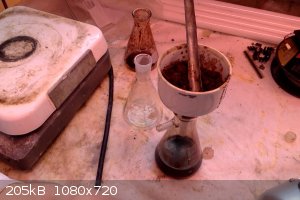 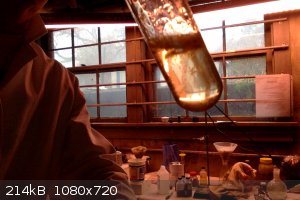
[Edited on 23-11-2014 by Cheddite Cheese]
|
|
|
blogfast25
International Hazard
    
Posts: 10562
Registered: 3-2-2008
Location: Neverland
Member Is Offline
Mood: No Mood
|
|
Geez, your shed looks a bit like mine. But you rack seems straighter...
Very nice progress, indeed.
|
|
|
Metacelsus
International Hazard
    
Posts: 2531
Registered: 26-12-2012
Location: Boston, MA
Member Is Offline
Mood: Double, double, toil and trouble
|
|
The second recrystallization was successful. I now have nice, colorless crystals (mass 12.61 g). I don't mind the loss much, as the purity is greatly
improved.
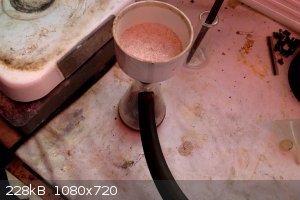
[Edited on 23-11-2014 by Cheddite Cheese]
|
|
|
Etaoin Shrdlu
National Hazard
   
Posts: 724
Registered: 25-12-2013
Location: Wisconsin
Member Is Offline
Mood: Insufferable
|
|
Oh wow, that second recrystallization looks very nice.
|
|
|
aga
Forum Drunkard
    
Posts: 7030
Registered: 25-3-2014
Member Is Offline
|
|
V. Nice !
Before anyone says anything about Cleanliness, a tidy shed, and a clean hotplate is not a sign of an organised mind : it is just proof of inactivity.
That shed and hotplate see Action a lot !
Edit:
The lab coat is too clean.
It looks brand new.
Borrowed a Prop for the photo shoot ?
[Edited on 23-11-2014 by aga]
|
|
|
Metacelsus
International Hazard
    
Posts: 2531
Registered: 26-12-2012
Location: Boston, MA
Member Is Offline
Mood: Double, double, toil and trouble
|
|
No, the stains are just out of the field of view.
|
|
|
CuReUS
National Hazard
   
Posts: 928
Registered: 9-9-2014
Member Is Offline
Mood: No Mood
|
|
i like the way you relate the structure of the compound with an object as it makes it more easy to remember and reproduce later
but TEMPO is a toy compared to Vitamin B12
that's one spaceship even Jedi would envy
http://books.google.co.in/books?id=JX7AAgAAQBAJ&pg=PA848...
back to my cyclic ether idea
the Sn2 reaction is influenced by strength and concentration of the nucleophile
so my logic of the N of ammonia entering the ring when the first O is protonated ,as N is a better nucloephile than O ,might actually work
now i just have to find the right name reaction to prove my point
[Edited on 25-11-2014 by CuReUS]
|
|
|
Etaoin Shrdlu
National Hazard
   
Posts: 724
Registered: 25-12-2013
Location: Wisconsin
Member Is Offline
Mood: Insufferable
|
|
Just making a mention that this is still open.
|
|
|
Metacelsus
International Hazard
    
Posts: 2531
Registered: 26-12-2012
Location: Boston, MA
Member Is Offline
Mood: Double, double, toil and trouble
|
|
The Clemmensen reduction is underway (refluxing as I post).
5 g oxo-amine hydrochloride (26 mmol) dissolved in 25 mL warm methanol
17 g Zn powder (260 mmol) (5x excess)
0.8 g Hg(NO3)2 (freshly prepared, and not isolated)
45 mL 12 M HCl (520 mmol)
Everything is going well so far, and I'll post pictures soon-ish.
The reduction is done (all the Zn is dissolved, at least). It took 3 hours. I'll do the workup tomorrow morning.
One question: I want to analyze the reaction products by TLC on silica gel plates. I'll probably analyze the freebases instead of the salts, since I
think that they will separate better. I doubt the compounds will fluoresce under UV light, so my question is: how can I visualize the results?
[Edited on 19-1-2015 by Cheddite Cheese]
|
|
|
Chemosynthesis
International Hazard
    
Posts: 1071
Registered: 26-9-2013
Member Is Offline
Mood: No Mood
|
|
It's been awhile since I've had to stain a TLC plate, but there are quite a few different ones you can choose from that you probably aren't
necessarily familiar with. Iodine, cerium sulfate, and vanillin may be among the most readily accessible general stains in keeping with the OTC nature
of the thread. Here are quite a few with preparations.
http://www.chemistry.mcmaster.ca/adronov/resources/Stains_fo...
|
|
|
Metacelsus
International Hazard
    
Posts: 2531
Registered: 26-12-2012
Location: Boston, MA
Member Is Offline
Mood: Double, double, toil and trouble
|
|
Clemmensen Reduction Pictures (1)
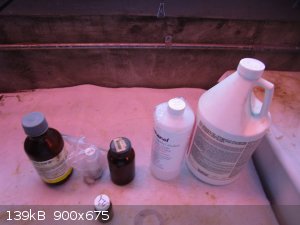
The reagents
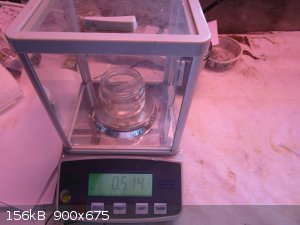
Mercury
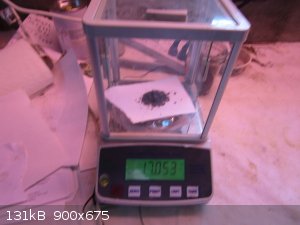
Zinc
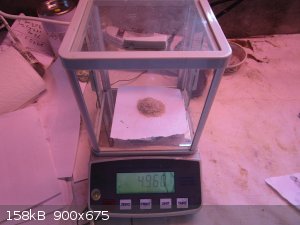
Substrate
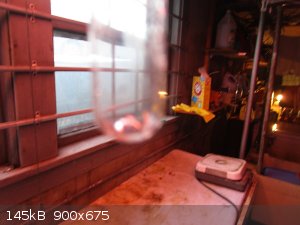
Mercury in a test tube
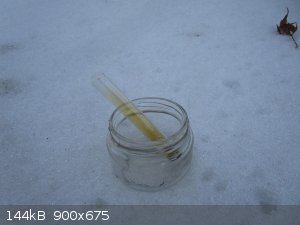
Dissolving mercury in nitric acid
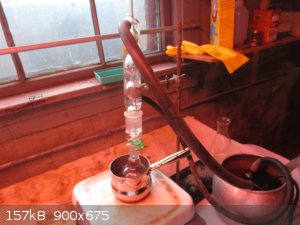
Refluxing the reaction mixture
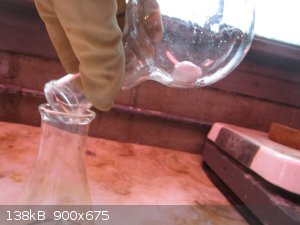
Three hours later: decanting the reaction mixture from the residue (mostly Hg)
[Edited on 19-1-2015 by Cheddite Cheese]
|
|
|
Metacelsus
International Hazard
    
Posts: 2531
Registered: 26-12-2012
Location: Boston, MA
Member Is Offline
Mood: Double, double, toil and trouble
|
|
Clemmensen Reduction Pictures (2)
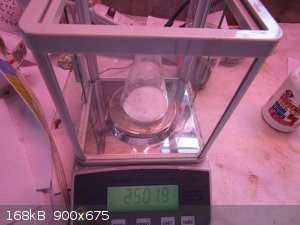
Sodium hydroxide
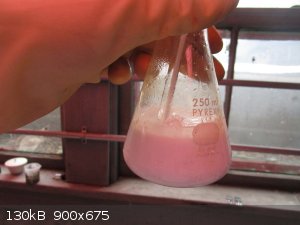
Extraction with toluene after basifcation (ppt. is Zn(OH)2)
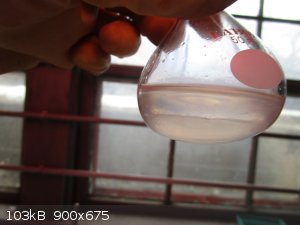
Extraction with hydrochloric acid
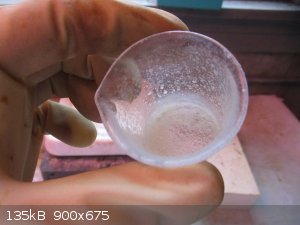
After evaporation of acid
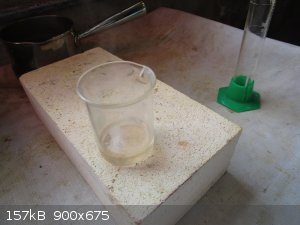
Recrystallization
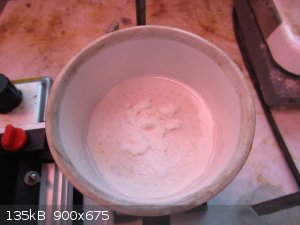
Collection of crystals by vacuum filtration
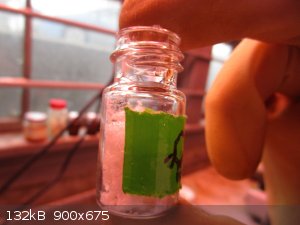
Close-up of crystals
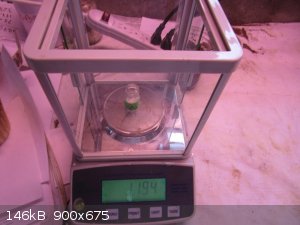
Mass of crystals is 1.194 g
As of now, I have not conclusively determined that the oxo group is gone. I will work on this over the next week (when I have time, at least).
About staining: I doubt the compound will react with iodine, and I don't have most of the other stains. I could try potassium permanganate, or
possibly dinitrophenylhydrazine (which I don't have, but could prepare, although I don't really want to).
[Edited on 19-1-2015 by Cheddite Cheese]
|
|
|
Metacelsus
International Hazard
    
Posts: 2531
Registered: 26-12-2012
Location: Boston, MA
Member Is Offline
Mood: Double, double, toil and trouble
|
|
TLC results
I finally got around to doing TLC. Compound before reduction is on the right, compound after reduction is on the left. Both compounds were spotted as
a solution of the hydrochloride. I used acetone to elute the plate, and alkaline permanganate as a stain. To get the stain to develop, I heated the
TLC plate on the hot plate at the lowest setting. The time between when the spots appeared and when all the permanganate had decomposed was only a few
minutes, but the spots were clearly visible as tan on a pink background, and I circled them lightly in pencil (sorry for the bad lighting in the
photo).
Retention factor for compound before reduction: 5.5 cm / 6.9 cm = 0.80
Retention factor for compound after reduction: 6.6 cm / 6.9 cm = 0.96
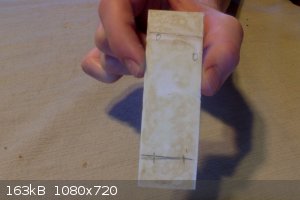
I wish I could have used a solvent less polar than acetone, but acetone was the least polar solvent I have that doesn't react easily with
permanganate. (I have toluene, but that would react.) Something like a mixture of hexanes and ethyl acetate (which I used in my organic chemistry lab
class) would be ideal. If these results don't meet the challenge expectations, I could try making some diethyl ether and using that. However, I think
that these results show clearly enough that the two compounds are pure, that they are different, and that the compound after reduction is less polar
than the compound before reduction.
Next step: oxidation to TEMPO. I plan to use Klute's method, with hydrogen peroxide. I'll start by concentrating some OTC 3% solution by gentle
evaporation.
[Edited on 22-3-2015 by Cheddite Cheese]
|
|
|
Etaoin Shrdlu
National Hazard
   
Posts: 724
Registered: 25-12-2013
Location: Wisconsin
Member Is Offline
Mood: Insufferable
|
|
Sorry I missed the January updates somehow. That looks fantastic.
|
|
|
byko3y
National Hazard
   
Posts: 721
Registered: 16-3-2015
Member Is Offline
Mood: dooM
|
|
Cheddite Cheese, you would really wanted to read this doc before attempting to do clemmensen on the mannich base (which is a OC-C-C-N group). See
attachment below.
Probably you've got an unsaturated compound. You didn't do the melting point check on the resulting amine, it would probably show if you've got the
right substance.
Also there's a successful synthesis of 4-oxo-xxxpyperidine and it's subsequent oxidation on this forum http://www.sciencemadness.org/talk/viewthread.php?tid=3960&a...
Attachment: Clemmensen reduction of mannich bases. Potential ganglionic and nicotinic agents.pdf (329kB)
This file has been downloaded 535 times
|
|
|
Chemosynthesis
International Hazard
    
Posts: 1071
Registered: 26-9-2013
Member Is Offline
Mood: No Mood
|
|
Very exciting; we have updates and dissent! Welcome aboard, byko3y.
|
|
|
| Pages:
1
2
3
4 |